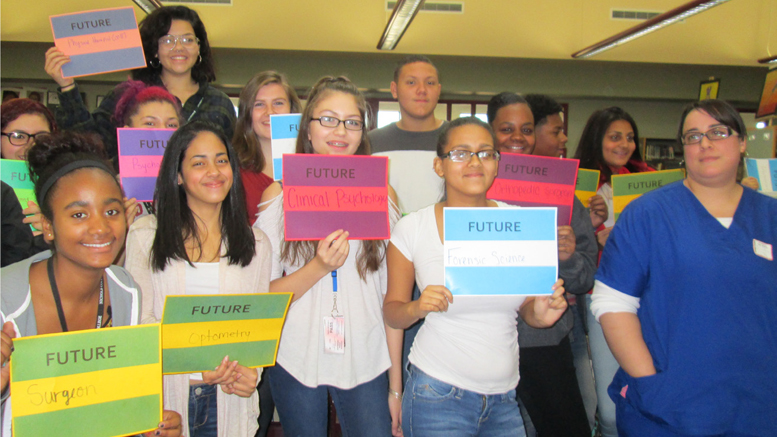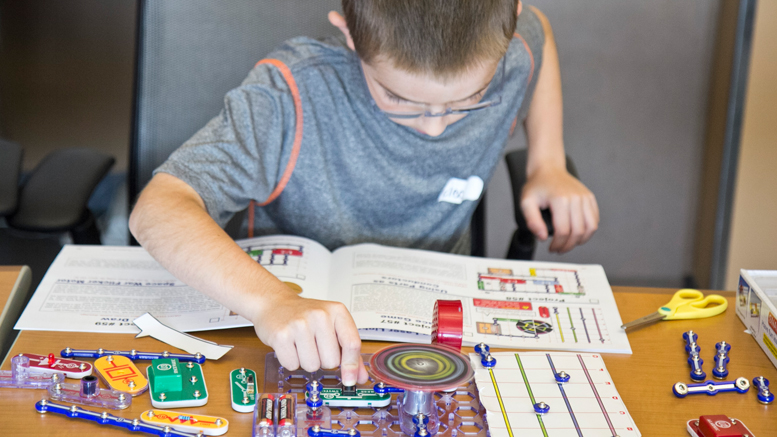While dual-enrollment programs have soared in recent years, many community colleges have also taken on additional collaborative initiatives with K-12 school systems, such as career workshops, outreach to high school staff, summer camps and more.
Hillsborough Community College in Florida, for example, augments its large dual-enrollment program with FUSE, a pathways program that connects high school students to HCC and to the University of South Florida.
FUSE offers guaranteed admission to the university to eligible graduates of eight associate-granting institutions including HCC, says Ginger Clark, vice president of academic affairs. Students must agree to complete an associate degree within three years in a major aligned with the region’s economic needs, such as information technology, life sciences, health sciences, advanced manufacturing and engineering. Now in its second semester, there are about 600 HCC students in FUSE.
LEAP Tampa Bay, a network of business, education, philanthropy and government partners, provided $3 million in scholarships last year for HCC students entering a FUSE pathway and for HCC graduates to enroll in USF. The scholarships are important because they allow students to attend HCC full time, says Karen Griffin, director of HCC’s associate of arts programs. Without that aid, students with jobs and family obligations would take much longer to graduate.
The message: college is possible
FUSE is just one of several K-12 initiatives aimed at creating “seamless transition opportunities” for secondary school students, Clark says. The Hillsborough Education Foundation also manages scholarships from Florida’s Take Stock in Children program to help low-income high school students with a GPA of at least 2.5.
HCC counselors begin working students in middle school “to instill in them the belief that they can go to college,” Clark says. “The idea of college comes alive for them; they believe really can do this.”
As part of HCC’s outreach activities, middle school students come to the college for campus tours and sessions on career options, what it takes to succeed in college and financial aid options. Similar sessions are held at middle and high schools targeted to minorities and financially disadvantaged students.

An elementary school student at a KICK summer camps hosted by Kirkwood Community College. (Photo: KCC)
An HCC employee based at the school district works with counselors and students at middle and high schools. HCC also sends a financial team to help high school students and their parents with the FAFSA and enrollment coordinators to answer questions about getting into college. “We try to be on site as much as possible,” Griffin says.
Every fall, the college invites high school guidance counselors to meet the president and learn about new programs and services. “It’s an ongoing dialogue,” Griffin says.
While K-12 outreach “does build the enrollment pipeline for us,” that’s not the driving motivation for HCC, Clark says. The main goal is getting students who might not have considered postsecondary education to see it as a viable option.
“We look at this in holistic manner,” Clark says. “Once they get here, the challenges are typically around academic and financial issues, so we’re addressing this at the middle and high school level.”
“The more we can get the word out, the better prepared they will be,” adds Griffin. For example, students who plan to go to college will be more likely to take algebra II in high school.
Supporting dual enrollment
All of these efforts go hand-in-hand with dual enrollment, which has grown significantly at HCC, currently encompassing more than 25,400 credit hours, the majority earned by high school students on HCC campus.
The extensive series of K-12 partnerships launched by El Paso Community College (EPCC) in Texas are also aimed at bolstering the college’s robust dual-credit program and early college high school. One key example is the El Paso Collaborative for Academic Excellence partnership, which looks at creating a pathway from public schools to EPCC and to the University of Texas at El Paso.
Much of EPCC’s efforts to connect with K-12 are driven by the need to improve educational attainment in a region where 80 percent of the population is Hispanic and nearly one-quarter of families live below the poverty level.
Data on those efforts show that EPCC has made a measurable impact on completion of degrees and certificates, increased transfer rates, improved student engagement and retention, and enhanced college readiness.
“Results are showing that these efforts are increasing the numbers of students who pursue postsecondary education and creating the mindset the college is necessary and accessible to all citizens,” says EPCC President William Serrata, a member of the American Association of Community Colleges board of directors.
EPCC faculty, staff and counselors actively participate in career day presentations at elementary, middle and high schools to encourage students to go to college and learn about degrees, majors and job opportunities. The college’s campuses regularly host youths on campus for scavenger hunts, STEM expos, academic competitions and other activities. And it’s Adopt an Elementary School Program builds strong elementary and college connections through campus tours, workshops, presentations, outreach programs and parental involvement.
“A student is never too young to learn the importance of going to college,” Serrata says. “Reaching out to elementary school students and their parents allows them to learn that higher education is within their reach and we build a college-going culture.”
Operation College Bound, a partnership between EPCC and the Socorro Independent School District, calls for EPCC’s recruitment and student services team, along with its higher education partners, to visit local high schools to share college and career information and lead interactive activities with students.
Some of EPCC’s other K-12 initiatives include:
- The Tejano Empowerment Network, which creates a college-going culture among Hispanic and other male students of color.
- A partnership with the STTE Foundation, K-12 schools and other higher educational institutions to host an annual STEAM/STEM fiesta to expose nearly 200 middle school students to EPCC programs.
- A program in conjunction with the Texas Workforce Commission, through which several hundred high schools students participate in competitions offered by EPCC programs in business, computer program and a “living on Mars” architecture competition.
- The Prudential Math In New Directions Explorers Camp, launched in 2017, which brings middle and high school students to EPCC for a week of hands-on activities, and the Prudential Mathmazing Fair brings math-related games and activities to elementary schools.
Preparing for college
In Massachusetts, Mount Wachusett Community College (MWCC) has a broad array of K-12 initiatives, most designed to improve access to the college. A federal Upward Bound program supports MWCC’s efforts to work with first-generation and lower-income students, starting in middle schools with a focus on STEM.
The goal is to “change the narrative that happens at home,” in which parents want their children to work and contribute to the family and don’t see college as an imperative, says Fagan Forhan, assistant dean of K-12 partnerships and civic engagement.
In addition to tutoring, mentoring and college tours, participating students can attend a five- or six-week summer residential program at Fitchburg State University, where they take classes in math and science and do career exploration activities.

These high school students are getting a jump start on health careers through Mount Wachusett Community College’s Project Healthcare. (Photo: MWCC)
Another federally funded program, Project Healthcare, supports two cohorts of high school juniors and seniors. The overarching goal is to diversify the healthcare profession, and also to increase enrollment at WMCC, Forhan says.
Participating students in an early college high school can simultaneously earn a certified nursing credential, high school diploma and college credits.
The U.S. Education Department awarded MWCC a $4.5 million GEAR UP (Gaining Early Awareness and readiness for Undergraduate Programs) grant in October to support academic counseling, mentoring, tutoring community service opportunities, academic workshops, college tours, financial planning and other readiness activities. The program reaches some 800 students in Fitchburg Public Schools, beginning in the sixth and seventh grade.
Overall, about a third of the students who take part in dual enrollment and other secondary school programs with MWCC end up at the college, Forhan says.
The entrepreneurial spirit
In another initiative, the United Way Youth Venture program, MWCC sends staff to 21 elementary, middle and high schools to help students create and design social entrepreneurship projects. Students determine what the idea of community means to them and the challenges they see; identify their own skills, interests and passions; put together a business plan for addressing that issue; and present their results.
One group of students launched their own nonprofit. Others proposed legislation, lobbied for a dog park, wrote a mental health curriculum that was ultimately including in legislation, organized a soccer program and sent mosquito nets to combat malaria.
MWCC provides grants of up to $1,000 to support high school students who participate in summer programs with the college, such as enrichment classes, dual enrollment, personal exploration activities and work experience through volunteerism.
Some of these students have family responsibilities and “they will have to make the choice between working at Dunkin Donuts and being with us, so we do everything we can to pay those students stipends for the summer,” Forhan says.
Summer camps
For Kirkwood Community College (KCC) in Iowa, outreach to the K-12 system is part of a continuum of engagement to get youths involved in postsecondary education and into jobs, says Kim Becicka, vice president of continuing education and training services.
KCC’s Workplace Learning Connection serves an as intermediary between K-12 and business and industry representatives to arrange internships and job shadowing experiences for high school students.
A key part of the college’s efforts to engage younger children is Kirkwood Interactive Camps for Kids (KICK), a summer program that focuses on fun STEM activities and career exploration. About 1,600 students participated in three- or five-day camps this summer. To ensure children from families that are struggling economically have a chance to attend, any child eligible for free or reduced-price school lunch per family can attend one camp free of charge every year. Popular sessions include welding, veterinary technology, healthcare, crime scene investigation, rockets, coding, robotics, website design, photography, how to build your own computer, how to create Minecraft characters, and how to create a You Tube account.
“We’re looking for ways to provide youths with a glimpse into careers that are educational and also engages them,” says Kristin Verhorevoort, KICK program developer.
KICK fits in with the college’s mission to provide opportunities for youths, to move more students into dual enrollment and to encourage high school graduates to become KCC students, Becicka says.
“We believe it influences student choice,” she says. “Any time you can get youths on campus and help them understand what college is all about, they will be more likely to eventually enroll.”

